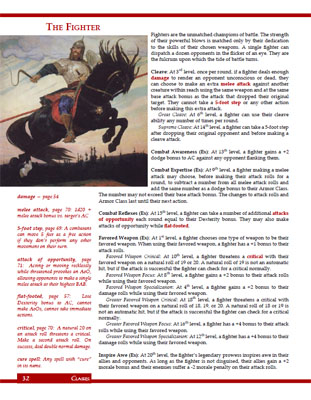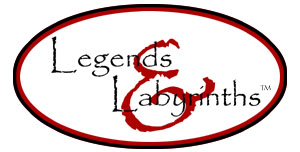There are six classes in Legends & Labyrinths: Barbarians, Clerics, Fighters, Rogues, Sorcerers, and Wizards.
Today we’re taking a sneak peek at the fighter:
Each class in Legends & Labyrinths receives an easy-to-reference two page spread. If you’re a player, you can lay your rulebook out on the table in front of you and have everything you need to know about your character class right at your fingertips. Everything else you need to know about your character could fit on a notecard! (But it won’t have to: We’ll be previewing our innovative character sheet in a couple of days.)
In addition to the SRS, you might also notice that the class abilities have been organized in alphabetical order (for easy reference). There’s also a thumb tab on the edge of the page indicating that you’re in Chapter 5. (These are located throughout the book to make quick-referencing easy.)
As I mentioned in “The Long Road”, there was a period of time in which Legends & Labyrinths was going to be positively over-flowing with classes: Barbarians, Bards, Cavaliers, Clerics, Duelists, Druids, Fighters, Monks, Paladins, Psions, Psychic Warriors, Rangers, Rogues, Scouts, Spellsongs, Sorcerers, and Wizards.
But that long list was bloating the game away from the simple, stream-lined rulebook I was hoping to produce. I whiplashed my way back to the 1975 Gang of 4: Cleric, Fighting-Man, Magic-User, Thief.
This shorter list eventually expanded into the Gang of 6 for a couple of reasons: First, I was deeply conflicted about whether to include the Sorcerer or the Wizard as my arcanist of choice. The Wizard, of course, provides the classic gameplay. On the other hand, I was very interested in Legends & Labyrinths providing a rulebook for new players and, in my experience, sorcerers are a better choice for newcomers.
Second, once I decided to include two arcanists, it made sense to “balance the scales” by providing two martial classes. Including the barbarian meant that I could focus both the barbarian and the fighter on distinct-yet-different styles of combat. Players could choose the style that suited their character best or use the multiclass rules to blend the two.
Finally, the Gang of 6 provided a nice balance for the six races I was including.
Six Races. Six Classes.
CLIMB INTO YOUR LABYRINTH AND FORGE YOUR LEGEND TODAY!














Greater Favored Weapon Focus: At 16th level, a fighter has a +4 bonus to their attack rolls while using their favored weapon.
Is the +4 intentional or was that supposed to be a +2?
interesting that there is nothing about skill points
I much prefer organization of class abilities by level. It allows you to more easily see the power progression of a class as they go up in level.
Or maybe at least provide the abilities by level in the table.
The abilities by level ARE in the Class Table.
Yup. Basically you get the information indexed both ways: If you want to see the level progression, look at the class table. If you’re looking to find how a specific ability works, you’ll find it alphabetically in the text.
This dual-utility is a lot like the spell lists: You want a list of all the spells at level X (which is why you have a spell list), but when you want to actually figure out how a given spell/ability works during play you don’t want to have to first figure out what level you get it at.
During playtests, we’ve found this gives a “best of both worlds” utility at the game table.
There IS a trade-off here in terms of learning the game: Like Wanderer says, being able to read through the class description and having an immediate sense of “how they progress” can be a valuable experience.
When faced with a trade-off between the one-time utility of learning the game and the long-term utility of using the rulebook during play, I’ll generally prefer the latter: If the game is any kind of success, you’ll be referencing it during play far more than you’ll be using it to learn how to play.
Of course, ideally, you can find a layout that satisfies both needs. The L&L layout at least minimizes this trade-off: It appears to be a minor inconvenience to reference the class table and then cross-reference to the ability descriptions (to get that sense of progress through the class). This is what I’ve seen most new players do: They look at the class table, see their 1st level ability, and then cross reference it into the text. (Often ignoring the rest of the class entirely.)
Having the entire class presented in a single, two-page spread helps with this. (No page-flipping.)
PDF TIP: If your eyesight isn’t too bad, it’s really easy to print each class-spread 2-up on a single 8.5×11 sheet. This creates a nifty little “tablemat” that a player can lay out in front of them.
@Dragatus: An additional +2 for a total bonus of +4. I’ll try tweaking that verbiage again. No matter which way I flipped it, half of my alpha readers were getting confused.
So, no feats then? Think this is nice and easy and they have the same “feats as class abillities” as in 3.5, overall… Nice doing.
I would probably even allow this as is as a alternative fighter class in Pathfinder with the normal feats added…
Excited to see the beta!
sorry double post: Even though I agree to the notion of usability in the alphabetic order of class abillities, the single entries under a caption, like under favoured weapon focus, should still be in level order. IMO in such a short list, it would be still easier and faster to find by level… even if you don’t know exactly if it’s the third or fourth entry, to find the one you need of some almost the same spelled class abilities is more complicated, if they are in alphabetical order.
Just my two cents…
Still excited to see the beta! 😉
So basically its 3rd edition with feat already chosen?
I think you’re overthinking the utility of the format. If I were a new player, the first thing I would ask is “why are the class abilities presented in two different ways?” And if I were given a copy of L&L as a primer, when I graduated to Pathfinder, I would ask “why is the format different?”
Even as someone who’s been playing for several years, I find the alphabetic format to be a barrier rather than a utility. (I also note the favored weapon entry as a particular example.) I find I want to skip around trying to read it in level order, and that interrupts the flow of the “narrative” as well as the learning process.
IMO, the brevity of the class description makes the appeal of alphabetizing irrelevant. It seems to impose an arbitrary-feeling order on something that already has a logical order, as well as an index (in the class table). Imagine if you were to alphabetize the SRS entries instead of ordering them as they appear in the text– that is how it seems to me.
Just my 2cp. Hope it’s helpful.
I think that the alphabetical order is really more a detriment than a help. When I looked at it at first, I was confused. After that, I realized the order was alphabetical, and I was less confused.
I have to say, the alphabetizing, particularly on a two page spread, is more confusing than useful. It’s one thing to have a whole chapter of feats to deal with, but class abilities are compact and don’t really require searching.